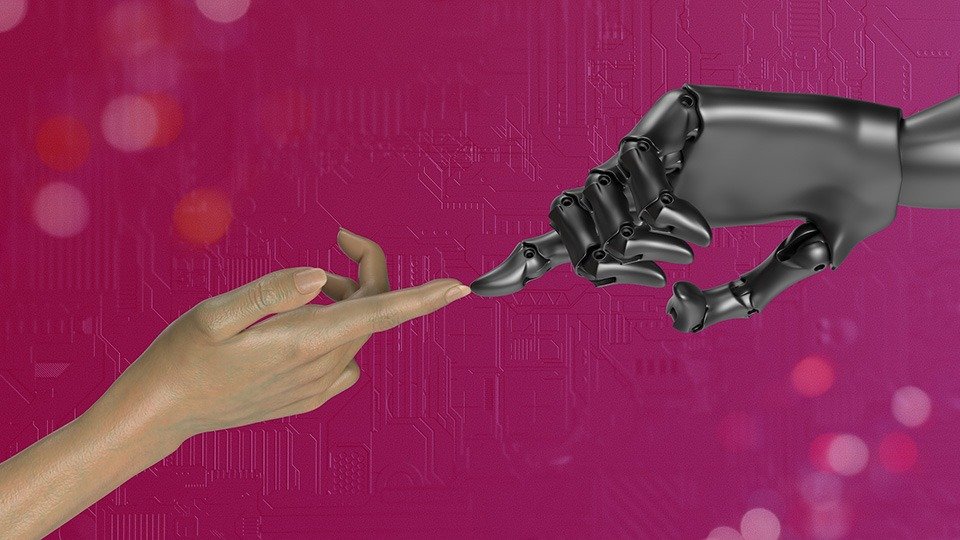Artificial Intelligence (AI) and Machine Learning (ML) are two closely related concepts that have revolutionized various industries. While both AI and ML overlap in many ways, they have distinct differences that are important to understand. AI refers to the simulation of human intelligence in machines, enabling them to perform tasks that typically require human cognition. On the other hand, ML is a subset of AI that focuses on the development of algorithms and statistical models, allowing machines to learn and make predictions or decisions without being explicitly programmed. AI encompasses a wide range of technologies and techniques that enable machines to mimic human behavior. It involves various subfields, such as natural language processing (NLP), computer vision, robotics, and more. The goal of AI is to create intelligent machines capable of reasoning, problem-solving, and adapting to new situations, just like humans. In contrast, ML is a specific approach within the AI domain. It relies on algorithms and statistical models to analyze and interpret complex data, learn from patterns and experiences, and make accurate predictions or decisions. While ML is a powerful tool for developing AI systems, not all AI applications necessarily involve ML. Understanding the differences between AI and ML is crucial for discerning how these technologies play a role in the advancement of various fields and how they can impact our daily lives.
What Is Artificial Intelligence? What Is Machine Learning? How Companies Use AI and Machine Learning AI Applications in Food Industry AI Applications in Banking AI Applications in Health Care.

What Is Artificial Intelligence?
What Does Artificial Intelligence Mean? In our fast-paced digital world, the idea of Artificial Intelligence (AI) has gotten a lot of attention and is being talked about a lot. AI has many uses and has the ability to change industries and make people better at what they do. But to fully understand how important AI is, you need to know how it works and what its basic ideas are. The study and creation of computer systems that can do things that normally require human intelligence is called artificial intelligence. Artificial intelligence’s main goal is to make robots that can think and solve problems like humans. The goal is to give machines the intelligence to think for themselves, learn from their mistakes, and make smart choices. AI is made up of many different techniques that help computers see, understand, think about, and react to their surroundings. These methods include things like computer vision, natural language processing, and machine learning. AI systems can look at huge amounts of data, find important patterns, and come up with useful insights by using these methods. AI’s ability to do natural language processing (NLP) is one of its most important features. NLP makes it possible for robots to understand and figure out what people are saying. It lets AI systems understand, create, and react to spoken or written language. This makes virtual assistants, language translation, and voice recognition technologies more useful. Computer vision is another important part of AI. Its goal is to make machines able to understand and analyze visual information from their surroundings. Computer vision algorithms let computers see things, figure out shapes, and look at pictures or movies and understand what they mean. This part of AI is used in technologies like self-driving cars, face recognition systems, and surveillance systems. A branch of AI called machine learning is very important for teaching computers how to learn and get better from experience without being told to do so. Creating algorithms that let computers look through huge amounts of data, find patterns, and then use that information to make predictions or choices is what it means. This skill has made big steps forward in fields like healthcare, finance, and marketing. AI systems need access to big datasets to train and improve their models because they run on data. AI has come a long way in the past few years thanks to the availability of “big data” and improvements in computer power and algorithms. AI systems can handle more difficult jobs and give more accurate results as they get more data and better models. AI has a huge range of possible uses in many different areas. AI can help doctors diagnose diseases, look at medical pictures, and guess how patients will do in the future. It can be used in finance to automate trade systems, find fraud, and give personalized financial advice. AI can also change transportation by making it possible for self-driving cars to drive themselves safely and quickly. While AI is still changing, moral issues also need to be thought about. Ethics in AI is the study of how to make sure that AI systems are built and used in a way that doesn’t hurt people or violate their rights. People are still arguing and discussing things like bias in decision-making systems and how AI will affect jobs. In conclusion, Artificial Intelligence is the most advanced field of computer science. Its goal is to make robots smart like humans. It uses many methods, like natural language processing, computer vision, and machine learning, to make robots see, understand, think, and act in ways that are similar to how humans do. AI has a lot of promise in many fields, and it will change the future and become an important tool for making people’s lives better. But as this technology gets better, it’s more important than ever to make sure it’s used and developed in a good way.
What Is Machine Learning?
What does machine learning mean? Machine learning is a branch of artificial intelligence (AI) that focuses on creating models and algorithms that let computers learn and make choices or predictions without being told to do so. It is a strong tool that lets computers learn from and look at a lot of data, find patterns or trends on their own, and make choices based on that data. To put it simply, machine learning is the idea of teaching a computer program how to do a certain job by giving it examples or data to learn from. These examples help the program find patterns, relationships, and hidden meanings in the data. It can then use these to guess what will happen next or decide what to do in similar cases. Machine learning algorithms come in many types, which can be used based on the job and the data that is available. A labeled dataset tells the algorithm what to do with each example, so the result or goal value is known. This is one of the most common ways to do things. The algorithm learns to find patterns or links between the traits it is given and the value it wants to achieve. This lets it make guesses about data it hasn’t seen before. Unsupervised learning, on the other hand, lets the algorithm look through material that hasn’t been labeled and find patterns. Because it doesn’t have any set goal values, it focuses on finding hidden patterns or similarities in the data. Often, this way of learning is used for things like finding clusters or strange things. You can teach a computer program to make decisions in a changing world using reinforcement learning, which is another type of machine learning. The algorithm learns by making mistakes and getting input from those mistakes in the form of rewards or punishments. It learns over time how to make the best decisions so that it gets the most rewards overall. Machine learning algorithms can be used in a lot of different areas and for a lot of different jobs. For example, in healthcare, they can be used to look at medical data and pictures to help find and treat diseases. When it comes to finance, machine learning algorithms can look at market data to guess stock prices or spot deals that aren’t what they seem to be. In marketing, they can be used to figure out how to make ads more relevant to each customer by looking at their habits and likes. One of the best things about machine learning is that it can handle and process a lot of data. Machine learning helps businesses get useful information from the growing amount of data that comes in different forms and from different sources. This lets them make decisions based on the data. Machine learning algorithms can help businesses find risks, improve results, and make processes more efficient by looking for patterns and trends in data. But there are some problems with machine learning. Because the quality and variety of the data are so important to how well the program works, it needs a lot of high-quality data to be trained. Choosing the right algorithm and parameters for a job can also be hard and need experience and trial and error on your part. Machine learning is a powerful tool in the field of artificial intelligence that lets computers learn from data and use that data to make predictions or choices. Machine learning can find patterns, insights, and correlations that would be hard or impossible to find with traditional programming methods because it trains algorithms on big datasets. Machine learning could change many businesses and lead to new ideas in the future, but it also brings some problems that need to be solved.
How Companies Use AI and Machine Learning
How businesses make use of AI and machine learning Artificial intelligence (AI) and machine learning have gotten a lot of attention and praise in recent years from a wide range of businesses. A lot of businesses have started using artificial intelligence and machine learning to make their processes better, give customers better experiences, and stay ahead of the competition. Organizations can automate tasks, get useful information from huge datasets, and make smart choices by using AI and machine learning. In this part, we’ll look at the different ways that businesses use AI and machine learning to come up with new ideas and make their processes run more smoothly. Customer service and help is a big area where AI and machine learning are used in business. Companies can help customers around the clock and quickly answer their questions by using chatbots and virtual assistants driven by AI. These smart computers are set up to quickly look over customer questions, give correct answers, and even solve difficult problems. Besides making customers happier, this also makes human support teams’ jobs easier, so they can focus on more important tasks. Electronic shopping is also being changed by artificial intelligence and machine learning. Companies use algorithms for machine learning to look at how customers act, what they like, and how often they buy things. Businesses can use this information to make product suggestions that are more relevant to the customer, offer more relevant deals, and make the shopping experience more fun. When businesses know what their customers want and need, they can increase sales, build brand trust, and keep more of their customers. Data analytics is another area where artificial intelligence and machine learning are changing the way things are done. Companies get huge amounts of information from a lot of different places, like social media, sales deals, interactions with customers, and more. The old ways of looking at this info often take too long and don’t work well. Artificial intelligence and machine learning, on the other hand, can help businesses simplify the process and get useful information in real time. For example, predictive analytics powered by machine learning algorithms can help businesses correctly predict demand, improve planning for production, and make the supply chain work better. This helps companies save money, keep their inventory levels just right, and give better customer service by making sure products are easy to find when and where they are required. By looking at patterns in data, businesses can also find hidden trends, spot market opportunities, and make choices based on data that lead to growth and new ideas. In the medical field, artificial intelligence and machine learning are making big steps forward in study, diagnosis, and treatment. These technologies can help doctors find diseases, make personalized treatment plans, and guess what will happen because they can process and analyze huge amounts of patient data. Diagnostic tools that are driven by AI can quickly understand medical images like x-rays and MRI scans. This helps find problems early and improves patient care. AI and machine learning have also changed how businesses in the financial sector handle risk, look for fraud, and choose investments. Machine learning programs can look at past financial data to guess what the market will do, make investment portfolios more profitable, and find possible risks. Artificial intelligence (AI)-based fraud detection systems can also spot odd transactions in real time, stopping fraud and keeping banks and their users safe. In conclusion, AI and machine learning are very important in many fields because they help businesses run more efficiently, give customers better experiences, and get ahead of the competition. These technologies are changing everything about how businesses work, from customer service to data analytics to healthcare to banking. AI and machine learning can help businesses not only be more efficient and productive, but also find new business chances and come up with new ideas. We can expect even more progress and use of AI and machine learning in the business world as these technologies continue to change.
AI Applications in Food Industry
AI Uses in the Food Industry One of the biggest and most important parts of the world economy is the food business. Different fields are still being changed by new technologies, and the food industry has also gone through big changes. Artificial intelligence (AI) is one of the most important tools that is causing this change. AI has changed how food is grown, processed, packaged, and delivered, making the food business more efficient and productive as a whole. Supply chain management is one of the most important ways that AI is used in the food business. Companies can improve their inventory management and cut down on waste by using AI to improve their logistics and delivery networks. AI programs can look at data in real time to figure out how demand will change and make sure that the right amount of food gets to the right place and time. These changes not only lower prices but also help keep food fresh and high-quality all along the supply chain. Food safety is another area where AI has had a big effect on the food business. Systems that are driven by AI can find and stop contamination and spoilage, which lowers the risk of getting sick from food. These systems can look at a lot of data from different sources, like temperature sensors and quality control records, using machine learning techniques to find possible risks and take steps to reduce them. This protects customers by making sure they get safe, high-quality food. AI is also very important in the production and preparation of food. Robots and machines that are controlled by AI can do boring, repetitive jobs like sorting and packaging without any human help. This makes operations more efficient and cuts costs. Also, these tools can check the quality of products faster and more accurately than people can, which makes sure that the quality of all products is always the same. Additionally, AI can be used to improve production processes by changing things like the amounts of ingredients or the cooking settings. This can make the finished foods taste and feel better. The way food is made and cooked is also changing because of AI. Chefs and home cooks can both use smart cooking appliances with AI technology to help them make delicious, custom meals. These tools can look at recipes, suggest different ingredients based on food allergies or personal tastes, and even suggest ways to cook. AI-powered cooking appliances can learn from what their users like and change their suggestions over time. This makes making meals easier and more fun. AI is also being used in personalized diet in addition to these other uses. Companies can use AI algorithms to look at health data about individuals, like genetic information or food tastes, and give them personalized food suggestions. This can help people choose foods that are good for their health and help them reach their goals, whether those goals are to lose weight, stay healthy, or just feel better overall. Overall, AI is changing the food business by making it easier to manage the supply chain, making food safer, speeding up production, changing how meals are made, and letting people customize their nutrition. Companies in the food industry can boost productivity, cut costs, and give customers better goods and services by using IBM Watson. As AI keeps getting better, we can expect more changes in the food business that will make it more sustainable and efficient.
AI Applications in Banking
The Use of AI in Banking Across many fields, artificial intelligence (AI) has become a disruptive technology. The banking business is no different. AI is changing how banks deal with customers, handle risk, find fraud, and make processes more efficient. It has the ability to change many parts of how banks work. In this part, we’ll talk about some of the most important ways AI is used in banking and the benefits they bring. Service to customers and how they feel: In the banking business, chatbots that are powered by AI are becoming more common. With these virtual helpers, banks can give personalized customer service and answer questions right away. Chatbots can understand and answer customer questions quickly and correctly by using natural language processing and machine learning techniques. This means that people don’t have to be involved as much. With this technology, banks can improve the customer experience by being available 24 hours a day, seven days a week, offering instant help, and quickly answering customer questions. Risk Management: Banks have to deal with a lot of financial transactions and private customer information, so risk management is very important to them. AI is very important for finding and reducing possible risks. AI algorithms can find patterns and oddities linked to fraud and other forms of fraud by looking at huge amounts of organized and unstructured data in real time. When fraud is found early and stopped, it saves money, keeps customer accounts safe, and stops fraud from happening. Credit Underwriting and Loan Approval: Algorithms driven by AI are changing the way credit is underwritten by automating and streamlining the loan approval process. Credit evaluation has always taken a long time and relies on a lot of historical data and analysis done by hand. AI algorithms, on the other hand, can correctly judge creditworthiness by looking at a huge amount of data from many sources, such as credit scores, income data, and transaction histories. This helps banks decide faster and with more information about which loans to approve. This cuts down on paperwork and makes the credit screening process run more smoothly overall. Investment guidance: AI is changing the way investment guidance services work by giving investors personalized advice. AI programs can give investors personalized investment advice by looking at their financial goals, risk tolerance, and market trends. AI algorithms can also keep an eye on the market all the time, which helps investors make smart investment choices and make the most of their portfolios. Investment advice is now more open to a wider range of people thanks to this technology, which makes traditional financial advisers less important. Compliance with Anti-Money Laundering (AML) Rules: Finding actions that launder money is a big problem in the banking industry. AI algorithms can correctly spot suspicious activities by looking at huge amounts of data from many sources, like transaction patterns, customer profiles, and regulatory databases. AI helps banks follow anti-money laundering rules and stop illegal activities by flagging possibly fraudulent transactions and sending out alerts. This protects the integrity of the financial system. AI has a lot of different uses in the banking industry. It helps banks provide better customer service, handle risk better, speed up credit approvals, improve investment advisory services, and make sure they follow all the rules set by regulators. As AI keeps getting better, it has the potential to change and improve the banking business in huge ways. If banks use AI technologies, they will be able to offer better, safer, and more personalized services to their users, giving them an edge over their competitors.
In conclusion, artificial intelligence and machine learning are related, but they work in different ways and have different roles. AI includes a lot of different technologies that try to make machines smart like humans. The goal is to make machines that can think, solve problems, and understand normal language. But machine learning is a branch of AI that studies the mathematical and statistical models that let computers learn from data and make guesses or choices based on that data without being explicitly programmed to do so. AI includes many different methods, but machine learning is one of the most powerful ones. It has changed many fields, from medicine to finance. It lets computers look at huge amounts of data, find patterns, and make good choices or predictions. Over time, machine learning models can get better at what they do by constantly learning from new data. AI and machine learning are both good and bad in different ways. With its wider scope, AI tries to copy human intelligence, but it has trouble with things like using common sense and knowing what’s going on around it. Because machine learning is based on data, it depends a lot on the quality and amount of data that is available for training. This means that skewed or incomplete datasets can affect how well it works. These problems show how important it is to carefully plan, follow strict development methods, and think about what is right and wrong when using AI and machine learning systems. Moving forward, the coming together of AI and machine learning will continue to change and shape the world we live in. Improvements in AI technologies and the strength of machine learning algorithms could completely change many fields, make decisions better, work more efficiently, and open up new possibilities. It is important to understand the differences and possibilities in these areas in order to use their full potential and make sure that intelligent systems are developed in a way that is responsible and decent so that they can live with humans and help them.




